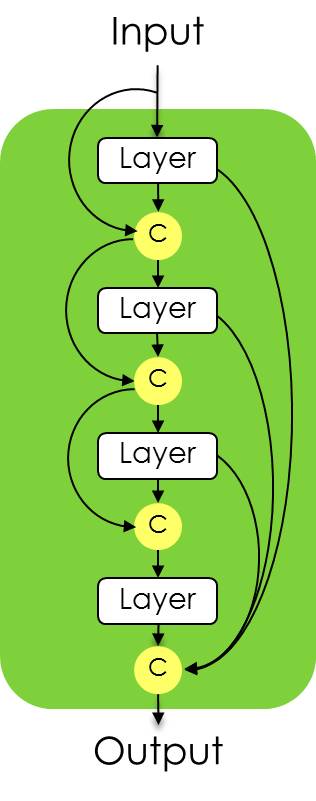DenseNet implementation of the paper Densely Connected Convolutional Networks in Keras
Now supports the more efficient DenseNet-BC (DenseNet-Bottleneck-Compressed) networks. Using the DenseNet-BC-190-40 model, it obtaines state of the art performance on CIFAR-10 and CIFAR-100
DenseNet is an extention to Wide Residual Networks. According to the paper:
The lth layer has l inputs, consisting of the feature maps of all preceding convolutional blocks.
Its own feature maps are passed on to all L − l subsequent layers. This introduces L(L+1) / 2 connections
in an L-layer network, instead of just L, as in traditional feed-forward architectures.
Because of its dense connectivity pattern, we refer to our approach as Dense Convolutional Network (DenseNet).
It features several improvements such as :
- Dense connectivity : Connecting any layer to any other layer.
- Growth Rate parameter Which dictates how fast the number of features increase as the network becomes deeper.
- Consecutive functions : BatchNorm - Relu - Conv which is from the Wide ResNet paper and improvement from the ResNet paper.
The Bottleneck - Compressed DenseNets offer further performance benefits, such as reduced number of parameters, with similar or better performance.
-
Take into consideration the DenseNet-100-12 model, with nearly 7 million parameters against with the DenseNet-BC-100-12, with just 0.8 million parameters. The BC model achieves 4.51 % error in comparison to the original models' 4.10 % error
-
The best original model, DenseNet-100-24 (27.2 million parameters) achieves 3.74 % error, whereas the DenseNet-BC-190-40 (25.6 million parameters) achieves 3.46 % error which is a new state of the art performance on CIFAR-10.
Dense Nets have an architecture which can be shown in the following image from the paper:
The accuracy of DenseNet has been provided in the paper, beating all previous benchmarks in CIFAR 10, CIFAR 100 and SVHN
Import the densenet.py script and use the DenseNet(...) method to create a custom DenseNet model with a variety of parameters.
Examples :
import densenet
# 'th' dim-ordering or 'tf' dim-ordering
image_dim = (3, 32, 32) or image_dim = (32, 32, 3)
model = densenet.DenseNet(classes=10, input_shape=image_dim, depth=40, growth_rate=12,
bottleneck=True, reduction=0.5)
Or, Import a pre-built DenseNet model for ImageNet, with some of these models having pre-trained weights (121, 161 and 169).
Example :
import densenet
# 'th' dim-ordering or 'tf' dim-ordering
image_dim = (3, 224, 224) or image_dim = (224, 224, 3)
model = densenet.DenseNetImageNet121(input_shape=image_dim)
Weights for the DenseNetImageNet121, DenseNetImageNet161 and DenseNetImageNet169 models are provided (in the release tab) and will be automatically downloaded when first called. They have been trained on ImageNet. The weights were ported from the repository https://github.com/flyyufelix/DenseNet-Keras.
- Keras
- Theano (weights not tested) / Tensorflow (tested) / CNTK (weights not tested)
- h5Py




